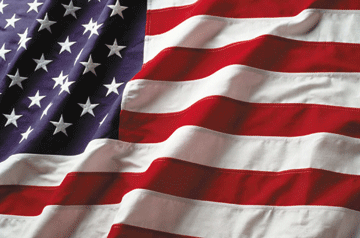|
|
|
Facts About the Flag
|
|

Proper Handling, Displaying, and Disposal of the Flag
With the recent revival of patriotism, many more people are flying flags. Here are
some tips on the proper way to display flags, followed by information on the proper disposal of flags.
The federal
flag code says the universal custom is to display the US flag from sunrise to sunset on buildings and stationary flagstaffs
in the open. However, when a patriotic effect is desired, the flag may be displayed 24-hours a day if properly illuminated
during the hours of darkness. Also, the US flag should not be displayed when the weather is inclement, except when an all-weather
flag is displayed.
Half Staff
On special days, the flag may be flown at half-staff. On Memorial
Day, it is flown at half-staff until noon and then raised.
-- Do not let the flag touch the ground.
-- Do
not fly flag upside down unless there is an emergency.
-- Do not carry the flag flat, or carry things in it.
--
Do not use the flag as clothing.
-- Do not store the flag where it can get dirty.
-- Do not use it as a cover.
-- Do not fasten it or tie it back. Always allow it to fall free.
-- Do not draw on, or otherwise mark the flag.
.
.
 For additional flag information, check out www.patriot-resource.com/flag_etiquette.htm, www4.law.cornell.edu/uscode/4/ch1.html, and http://www.ushistory.org/betsy/faq.htm. The Star Spangled Banner was composed
by Francis Scott Key, "In Defense of Fort McHenry" in September 1814. Congress proclaimed it the U.S. National Anthem
in 1931. Oh, say, can you see, by the dawn's early light,
What so proudly we hail'd at the twilight's last gleaming?
Whose broad stripes and bright stars, thro' the perilous fight,
O'er the ramparts we watch'd, were so gallantly
streaming?
And the rockets' red glare, the bombs bursting in air,
Gave proof thro' the night that our flag was
still there.
O say, does that star-spangled banner yet wave
O'er the land of the free and the home of the brave?
On the shore dimly seen thro' the mists of the deep,
Where the foe's haughty
host in dread silence reposes,
What is that which the breeze, o'er the towering steep,
As it fitfully blows, half
conceals, half discloses? Now it catches the gleam of the morning's first beam,
In full glory reflected, now shines on the stream:
'T is the star-spangled banner: O, long may it wave
O'er the land of the free and the home of the brave! And where is that band who so vauntingly swore
That the havoc of war
and the battle's confusion
A home and a country should leave us no more?
Their blood has wash'd out their foul
footsteps' pollution.
No refuge could save the hireling and slave
From the terror of flight or the gloom of the
grave:
And the star-spangled banner in triumph doth wave
O'er the land of the free and the home of the brave.
O, thus be it ever when
freemen shall stand,
Between their lov'd homes and the war's desolation;
Blest with vict'ry and peace, may the
heav'n-rescued land
Praise the Pow'r that hath made and preserv'd us as a nation!
Then conquer we must, when our
cause. it is just,
And this be our motto: "In God is our trust"
And the star-spangled banner in triumph
shall wave
O'er the land of the free and the home of the brave! History:
In 1814, about a week after the city of Washington had been badly burned, British troops moved up to the primary port at Baltimore
Harbor in Maryland. Frances Scott Key visited the British fleet in the Harbor on September 13th to secure the release of Dr.
William Beanes who had been captured during the Washington raid. The two were detained on the ship so as not to warn the Americans
while the Royal Navy attempted to bombard Fort McHenry. At dawn on the 14th, Key noted that the huge American flag, which
now hangs in the Smithsonian's American History Museum, was still waving and had not been removed in defeat. The sight inspired
him to write a poem entitled Defense of Fort McHenry; later the poem was set to music that had been previously composed for
another song by a Mr. Smith. The end result was the inspiring song now considered the national anthem of the United States
of America. It was accepted as such by public demand for the next century or so, but became even more accepted as the national
anthem during the World Series of Baseball in 1917 when it was sung in honor of the brave armed forces fighting in the Great
War. The World Series performance moved everyone in attendance, and after that it was repeated for every game. Finally, on
March 3, 1931, the American Congress proclaimed it as the national anthem, 116 years after it was first written.National
9/11 Flag Other
Flags and Order of Precedence for Flag Display Order of precedence for service
flags:


|
|